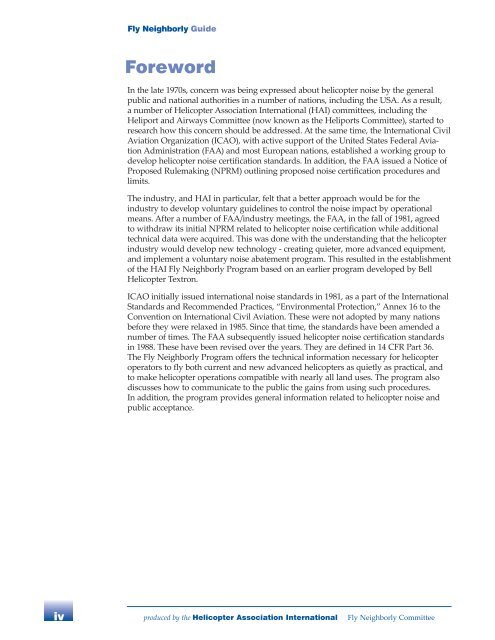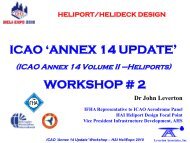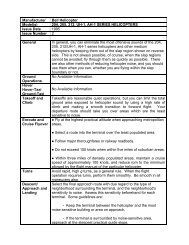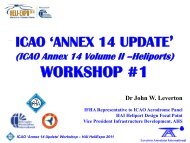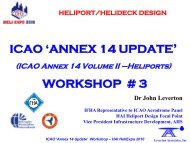Fly Neighborly Guide - Helicopter Association International
Fly Neighborly Guide - Helicopter Association International
Fly Neighborly Guide - Helicopter Association International
You also want an ePaper? Increase the reach of your titles
YUMPU automatically turns print PDFs into web optimized ePapers that Google loves.
<strong>Fly</strong> <strong>Neighborly</strong> <strong>Guide</strong>ForewordIn the late 1970s, concern was being expressed about helicopter noise by the generalpublic and national authorities in a number of nations, including the USA. As a result,a number of <strong>Helicopter</strong> <strong>Association</strong> <strong>International</strong> (HAI) committees, including theHeliport and Airways Committee (now known as the Heliports Committee), started toresearch how this concern should be addressed. At the same time, the <strong>International</strong> CivilAviation Organization (ICAO), with active support of the United States Federal AviationAdministration (FAA) and most European nations, established a working group todevelop helicopter noise certification standards. In addition, the FAA issued a Notice ofProposed Rulemaking (NPRM) outlining proposed noise certification procedures andlimits.The industry, and HAI in particular, felt that a better approach would be for theindustry to develop voluntary guidelines to control the noise impact by operationalmeans. After a number of FAA/industry meetings, the FAA, in the fall of 1981, agreedto withdraw its initial NPRM related to helicopter noise certification while additionaltechnical data were acquired. This was done with the understanding that the helicopterindustry would develop new technology - creating quieter, more advanced equipment,and implement a voluntary noise abatement program. This resulted in the establishmentof the HAI <strong>Fly</strong> <strong>Neighborly</strong> Program based on an earlier program developed by Bell<strong>Helicopter</strong> Textron.ICAO initially issued international noise standards in 1981, as a part of the <strong>International</strong>Standards and Recommended Practices, “Environmental Protection,” Annex 16 to theConvention on <strong>International</strong> Civil Aviation. These were not adopted by many nationsbefore they were relaxed in 1985. Since that time, the standards have been amended anumber of times. The FAA subsequently issued helicopter noise certification standardsin 1988. These have been revised over the years. They are defined in 14 CFR Part 36.The <strong>Fly</strong> <strong>Neighborly</strong> Program offers the technical information necessary for helicopteroperators to fly both current and new advanced helicopters as quietly as practical, andto make helicopter operations compatible with nearly all land uses. The program alsodiscusses how to communicate to the public the gains from using such procedures.In addition, the program provides general information related to helicopter noise andpublic acceptance.ivproduced by the <strong>Helicopter</strong> <strong>Association</strong> <strong>International</strong> n <strong>Fly</strong> <strong>Neighborly</strong> Committee


